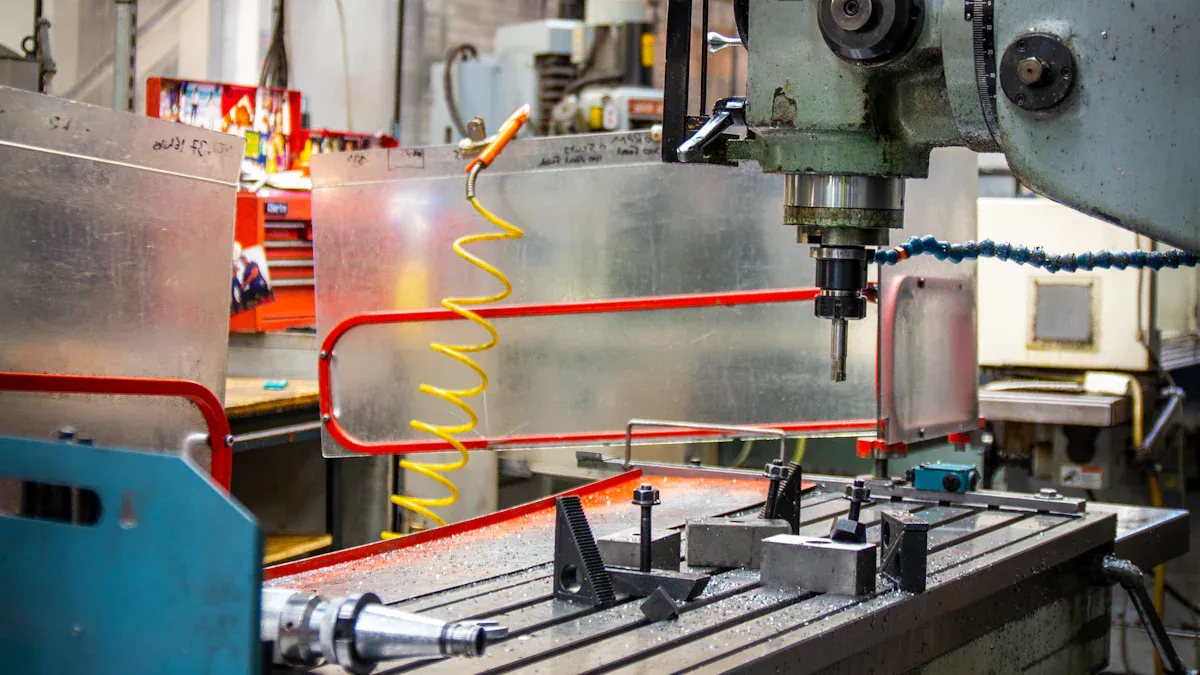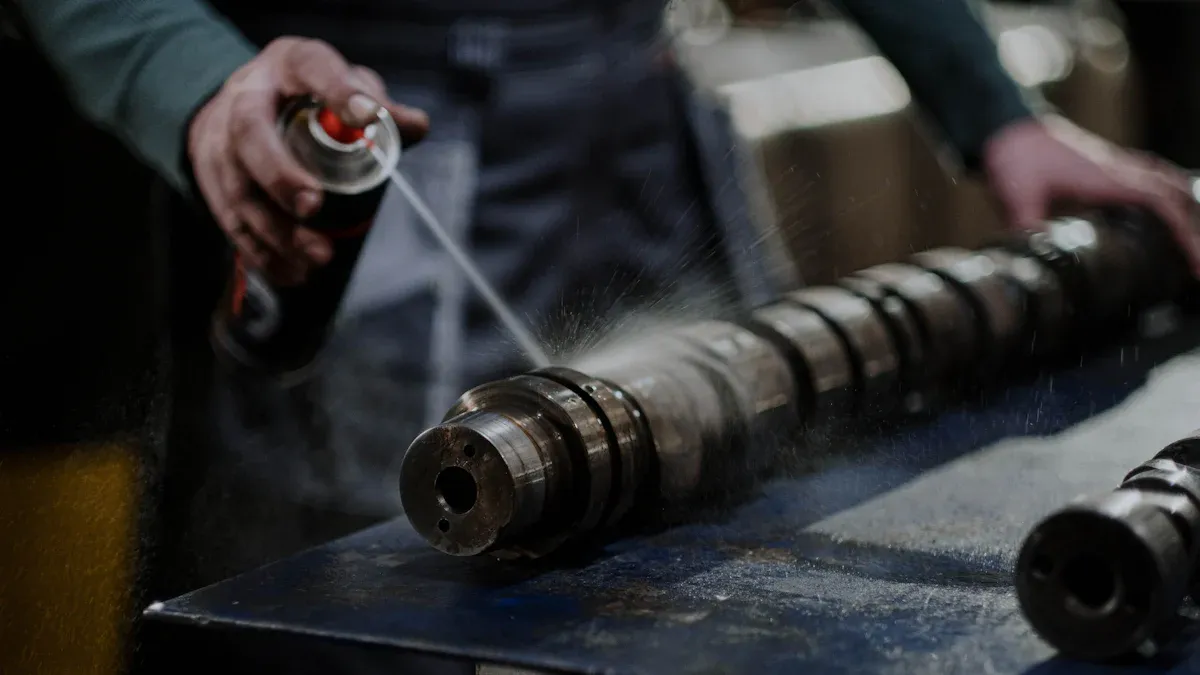
Stainless Steel 304 Precision Casting plays a vital role in automotive durability. Its high strength, corrosion resistance, and ability to withstand extreme conditions make it indispensable. For example, components like the outlet chamber in EGR coolers benefit from its thin-walled, complex structure, ensuring reliability in harsh environments while maintaining precision through advanced manufacturing techniques like Lost Wax Casting Stainless Steel. Additionally, the use of Stainless Steel Investment Casting further enhances the performance of these components, allowing for High Precision Investment Casting that meets the demanding specifications of modern automotive engineering.
Key Properties of Stainless Steel 304

High Strength and Toughness
Stainless steel 304 stands out for its impressive mechanical properties, making it a reliable choice for automotive components like the outlet chamber in EGR coolers. Its high strength ensures durability under stress, while its toughness minimizes the risk of fractures. These qualities are essential for parts that face constant wear and tear.
| Property | Description |
|---|---|
| Ultimate Tensile Strength | Maximum stress before fracturing, indicating high strength. |
| Yield Strength | Stress limit for elastic deformation, allowing for shaping and manipulation. |
| Rockwell B Hardness | Moderate hardness (70) balances resistance to surface deformation and ductility. |
| Modulus of Elasticity | High value (193-200 GPa) ensures shape retention under stress, enhancing reliability. |
| Shear Modulus | Approximately 86 GPa, indicating resistance to deformation under shear stress. |
| Charpy Impact Score | High score indicates ability to absorb energy, enhancing toughness and reducing fracture risk. |
These properties make stainless steel 304 an ideal material for precision casting, ensuring components like the outlet chamber maintain their structural integrity even in demanding conditions.
Exceptional Corrosion Resistance
Corrosion resistance is another hallmark of stainless steel 304. It performs exceptionally well in various environments, including those with high humidity or exposure to chemicals. This makes it a preferred material for automotive exhaust systems, where components like the outlet chamber must withstand corrosive gases.
- 304 stainless steel resists pitting and crevice corrosion, especially in chloride-containing environments.
- Its ability to maintain performance in such conditions ensures long-term reliability.
However, for environments with high chloride exposure, such as marine applications, other grades like 316 may offer better resistance. Still, stainless steel 304 remains a versatile and cost-effective choice for most automotive applications.
Performance in Extreme Conditions
Stainless steel 304 excels in high-temperature environments, making it suitable for components like EGR coolers that handle exhaust gases. It retains its strength up to 870°C, ensuring reliable performance in intermittent high-temperature applications.
| Temperature Range | Performance Metric | Notes |
|---|---|---|
| Up to 870°C | Retains strength | Suitable for high-temperature applications |
| 425°C – 860°C | Reduced corrosion resistance | Sensitization may occur, affecting long-term use |
While it performs well under most conditions, extreme environments may require alternative alloys like 310 or 316 for enhanced resistance. Nevertheless, stainless steel 304 remains a robust choice for automotive precision casting, balancing performance and cost efficiency.
The Role of Precision Casting in Durability

Steps in Stainless Steel 304 Precision Casting
Precision casting is a meticulous process that ensures components like the outlet chamber in EGR coolers meet exact specifications. The journey begins with creating a wax model of the part. This model is coated with ceramic material to form a mold. Once the mold hardens, the wax is melted away, leaving a cavity for molten stainless steel 304. The steel is poured into the mold, cooled, and then removed to reveal the cast part.
Recent advancements have made this process even more efficient. Additive manufacturing now allows for the creation of intricate designs with minimal waste. Automation and robotics streamline production, while smart foundries use digital monitoring systems to optimize every step. These innovations ensure that parts like the outlet chamber, known for its thin-walled and complex structure, are produced with exceptional precision and durability.
Quality Control in Precision Casting
Quality control is critical in precision casting to ensure the final product meets industry standards. For stainless steel 304 precision casting, manufacturers follow strict protocols to maintain consistency and reliability. Here’s a breakdown of key measures:
| Quality Control Measure | Description |
|---|---|
| ASTM A995 | Ensures proper heat treatment and chemical analysis for austenitic-ferritic stainless steel. |
| Heat Treatment | Prevents precipitate formation by applying optimal heating and rapid cooling. |
| Heat and Product Analysis | Verifies that the chemical composition aligns with required standards. |
| Tension Test | Confirms mechanical properties like tensile and yield strength. |
| ASTM A890 | Focuses on heat treatment and corrosion resistance for stainless steel. |
These measures are especially important for parts like the outlet chamber, which must withstand high temperatures and corrosive environments. For example, airtightness tests ensure the part can handle 500kPa of compressed air without leakage. This rigorous testing guarantees that every component performs reliably in demanding automotive applications.
Benefits of Stainless Steel 304 Precision Casting for Automotive Applications
Resistance to Wear and Tear
Automotive components face constant mechanical stress, making wear resistance a critical factor. Stainless steel 304 excels in this area due to its unique properties:
- Superior corrosion resistance protects against surface degradation.
- High tensile strength ensures components can endure heavy loads.
- Excellent formability allows for intricate designs without compromising durability.
- Impact resistance minimizes damage from sudden forces.
These qualities make stainless steel 304 ideal for parts like the outlet chamber in EGR coolers. The material’s ability to form hard carbides and nitrides further enhances its durability. This ensures a longer lifespan for components, even under challenging conditions.
Corrosion Resistance in Harsh Environments
Automotive parts often operate in environments that promote corrosion. Stainless steel 304 offers exceptional resistance, ensuring reliability in various settings:
| Environmental Condition | Performance |
|---|---|
| Atmospheric Settings | Resists rust and staining in industrial and coastal environments. |
| Freshwater and Potable Water | Maintains integrity and appearance over time. |
| Acidic Environments | Resists organic acids but struggles with strong acids like hydrochloric acid. |
For example, the outlet chamber in EGR coolers benefits from this corrosion resistance, maintaining performance even when exposed to exhaust gases. While 304 stainless steel may develop pits in chloride-rich environments, it remains a cost-effective choice for most automotive applications.
Longevity and Cost Efficiency
Stainless steel 304 precision casting combines durability with cost efficiency. The material’s long lifespan reduces the need for frequent replacements, saving both time and money. Additionally, the precision casting process allows for complex geometries, minimizing material waste and ensuring high production yields. For instance:
- Investment casting is cost-effective for medium to large production runs.
- A 60% process yield can significantly lower costs compared to lower yields.
The outlet chamber, with its thin-walled and complex structure, exemplifies this efficiency. Developed in 2020 and mass-produced since 2021, it demonstrates how stainless steel 304 precision casting meets high-performance standards while remaining economical.
Real-World Applications of Stainless Steel 304 Precision Casting
Exhaust Systems and EGR Coolers
Stainless steel 304 precision casting plays a crucial role in automotive exhaust systems, especially in components like EGR coolers. These systems rely on parts such as the outlet chamber, which must endure high temperatures and corrosive gases. The outlet chamber, made from stainless steel 304, exemplifies durability and precision. Its thin-walled, complex structure ensures efficient gas treatment while maintaining structural integrity.
| Specification | Details |
|---|---|
| Part Name | Outlet Chamber |
| Dimensions (LxWxH) | 132mm x 55mm x 85mm |
| Wall Thickness | 2.5mm |
| Weight | 351g |
| Material | Stainless Steel 304 |
| Application | EGR Cooler in exhaust system |
| Testing Requirement | Airtightness test at 500kPa, no leakage for 1 min |
Stainless steel 304 enhances exhaust system performance by retaining heat effectively. This prevents excessive heat loss, maintaining higher exhaust velocity. As a result, the system achieves better scavenging at the collector, improving overall efficiency. Its resistance to corrosion and ability to withstand high temperatures further boost the durability of these critical components.
Engine Components
Engine components benefit significantly from stainless steel 304 precision casting. This material’s high strength-to-weight ratio and heat resistance make it ideal for parts exposed to extreme conditions. Commonly manufactured components include:
- Engine parts
- Exhaust elements
- Structural components
These parts contribute to vehicle longevity and performance. For instance, stainless steel 304 ensures durability under stress, while its heat resistance allows it to perform reliably in high-temperature environments.
| Advantage | Description |
|---|---|
| Strength | High strength-to-weight ratio ensures durability and contributes to vehicle longevity and performance. |
| Heat Resistance | Ability to withstand high temperatures makes it suitable for engine components and exhaust systems. |
| Durability | Enhanced durability contributes to the overall performance and lifespan of automotive components. |
Structural Parts
Structural components like frames and chassis reinforcements also rely on stainless steel 304. This material’s excellent corrosion resistance and tensile strength ensure these parts can withstand significant stress. By resisting environmental contaminants, stainless steel 304 minimizes maintenance needs. This enhances the longevity of structural components, making vehicles safer and more durable.
Tip: Stainless steel 304’s formability allows manufacturers to create intricate designs without compromising strength. This versatility makes it a top choice for automotive structural parts.
Stainless Steel 304 Precision Casting delivers unmatched durability by combining material excellence with advanced manufacturing techniques. Its corrosion resistance and high-temperature tolerance ensure automotive components, like the outlet chamber in EGR coolers, perform reliably in harsh conditions. This durability reduces maintenance and replacement costs, making it a cost-efficient choice for manufacturers. 🚗
FAQ
What is the outlet chamber, and why is it important?
The outlet chamber is a stainless steel 304 component used in EGR coolers. Its high-temperature and corrosion resistance make it essential for efficient exhaust gas treatment in vehicles.
How does stainless steel 304 improve automotive durability?
Stainless steel 304 offers high strength, corrosion resistance, and heat tolerance. These properties ensure components like the outlet chamber last longer, even in harsh conditions.
What makes the outlet chamber unique in its design?
Its thin-walled, complex structure requires precise casting to prevent deformation. High positional accuracy and sealing requirements make it a standout in precision engineering.
